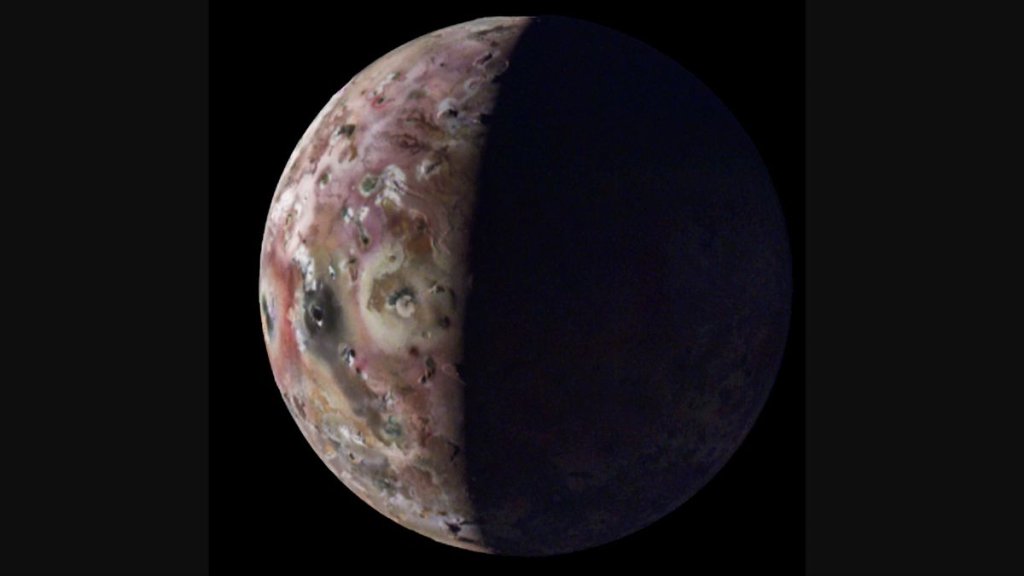
NASA’s Juno probe captures amazing views of Jupiter’s volcanic moon Io (video) (Image Credit: Space.com)
The four biggest moons of Jupiter aren’t just blurry smudges in Galileo’s telescope anymore.
The Italian astronomer Galileo Galilei discovered Ganymede, Callisto, Europa and Io back in 1610, which explains why they’re called the Galilean moons. We’ve learned a lot about these exotic bodies in the past 400 years thanks to ever-improving telescope views and close-up imagery snapped by voyaging spacecraft like NASA’s Juno Jupiter orbiter.
Indeed, Juno recently conducted two close flybys of Io, the most volcanically active body in the solar system, and data from the encounters is wowing scientists.
Related: NASA’s Juno probe sees active volcanic eruptions on Jupiter’s volcanic moon Io (images)

“Io is simply littered with volcanoes, and we caught a few of them in action,” Scott Bolton, Juno’s principal investigator, said in a NASA statement on Thursday (April 18).
“We also got some great close-ups and other data on a 200-kilometer-long (127-mile-long) lava lake called Loki Patera,” Bolton added. “There is amazing detail showing these crazy islands embedded in the middle of a potentially magma lake rimmed with hot lava. The specular reflection our instruments recorded of the lake suggests parts of Io’s surface are as smooth as glass, reminiscent of volcanically created obsidian glass on Earth.”
Juno came within about 930 miles (1,500 kilometers) of Io’s roiling surface during the two flybys, which occurred in December 2023 and February 2024. Mission team members processed the encounter data into a flyover animation, which provides a dazzling view of the moon.
Maps created with Juno data recently also have shown that Io’s surface is smoother than those of the other Galilean moons, and that Io’s poles are colder than its mid-latitude regions, mission team members said.
Jupiter, too
Juno has also collected intriguing information about the poles of Jupiter recently using its Microwave Radiometer (MWR) instrument, including differences among the gas giant’s intriguing north polar cyclones.
“Perhaps [the] most striking example of this disparity can be found with the central cyclone at Jupiter’s north pole,” Steve Levin, Juno’s project scientist at NASA’s Jet Propulsion Laboratory in Southern California, said in the same statement.
“It is clearly visible in both infrared and visible light images, but its microwave signature is nowhere near as strong as other nearby storms,” Levin added. “This tells us that its subsurface structure must be very different from these other cyclones.”
The Juno team is also learning more about Jupiter’s water abundance. The scientists aren’t looking for flowing lakes and rivers — Jupiter has no discernible surface, after all — but rather for oxygen and hydrogen molecules in its thick atmosphere. Such work follows on from that done by NASA’s Galileo Jupiter orbiter, which ended its mission with an intentional death dive into Jupiter’s atmosphere in 1995.
Galileo “did amazing science, but its data was so far afield from our models of Jupiter’s water abundance that we considered whether the location it sampled could be an outlier. But before Juno, we couldn’t confirm,” Bolton said. “Now, with recent results made with MWR data, we have nailed down that the water abundance near Jupiter’s equator is roughly three to four times the solar abundance when compared to hydrogen. This definitively demonstrates that the Galileo probe’s entry site was an anomalously dry, desert-like region.”
While there are still many questions surrounding how Jupiter formed, scientists continue to rely on data coming in from Juno’s extended mission. The probe’s next close flyby of Jupiter — its 61st overall — will be on May 12.





